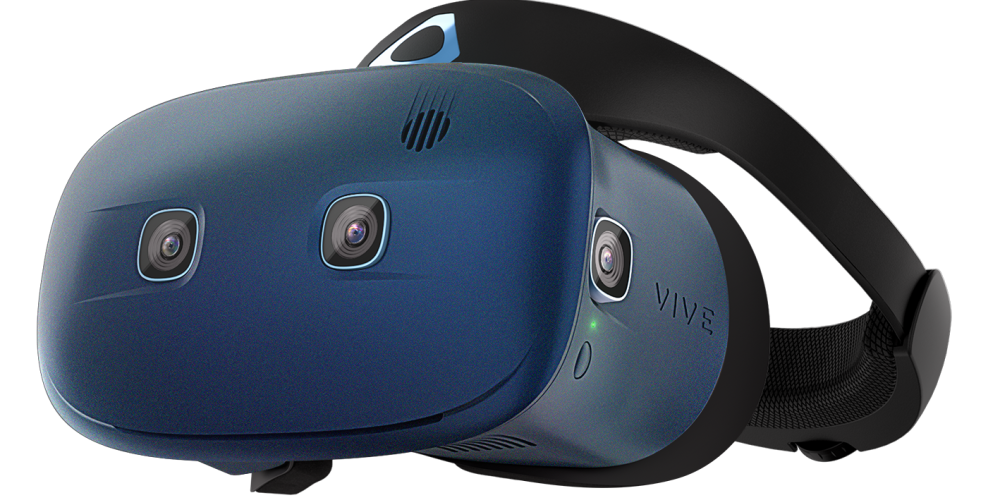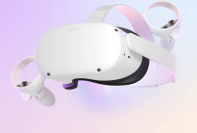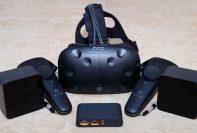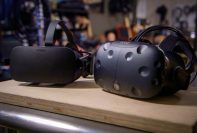Even though plenty of other competitors are now entering the VR market, Oculus and HTC are still two of the main contenders, duking it out for the top spot.
Oculus just released the Quest 2, their new generation standalone headset, and they’re pushing hard to make it their flagship product since it outshines even the Rift S.
Since HTC is currently marketing the Vive Cosmos as their answer to Oculus’s Quest headsets, it just makes sense to compare the two.
Keep in mind, however, that while the Quest 2 is standalone, it does support PC VR as well through the Oculus Link cable (which needs to be purchased separately).
The Vive Cosmos can also go wireless through the Vive Wireless adapter, and neither the Quest nor the Cosmos requires base stations for tracking.
So, even though the Cosmos relies on a PC in order to work, the two are still comparable.
Hardware Specs
| Vive Cosmos | Oculus Quest 2 | |
| Tracking | 6DOF Inside-Out Tracking | 6DOF Inside-Out Tracking |
| Processor | n/a | Qualcomm’s Snapdragon XR2 Chip |
| Lens per Eye Resolution | 1,440 × 1,700 | 1,832 × 1,920 |
| Display | LCD | LCD |
| Refresh Rate | 90 Hz | 72Hz / 90Hz |
| Memory | n/a | 6GB of RAM |
| Storage | n/a | 64 GB / 256 GB |
| Battery Life | Vive Adapter: 2.5 hours* | 2 -3 hours* |
*Of continuous play.
On the surface, there are a number of similarities between the hardware on these two headsets.
Both use inside-out 6 degrees of freedom (6DOF) for tracking your movements, although the Vive Cosmos has 6 camera sensors onboard compared to the Quests’ 4 cameras.
That might seem like a knock in the Quest’s defense, but it’s a pretty tough contender, and having fewer cameras doesn’t seem to slow it down in the least.
In fact, it sometimes feels like it tracks the controllers’ movements better than the Cosmos does.
The display is where the real difference comes into play, as the Oculus Quest 2 sports a better resolution than the Cosmos, by quite a bit.
Having more pixels by inch means you get a sharper image and less of a screendoor effect, so it’s definitely something that VR users want to take into consideration as it can make a big difference in the experience you’ll be getting.
Currently, the Quest 2 is a big upgrade in that department, and most of the headsets currently on the market can’t compete – with the exception of the Pimax headsets and the HP Reverb headsets.
Both the Quest 2 and Cosmos headsets use LCD displays, however, which are considered less ideal since you miss out on those “true blacks”.
However, it’s not as noticeable on either display, and both still feature-rich RGB colors.
Performance-wise, any apps or games that are a bit more demanding (or just not optimized specifically for the Quest 2) aren’t generally going to perform as well on the standalone Quest as they will on the Cosmos.
But if you plug that baby into a PC you’ll see virtually no difference. Actually, that’s not true.
Things might look even better on the Quest 2 thanks to its greater resolution.
Comfort
The Cosmos comes with a super comfy design that you have to pay extra for if you want the same level of experience as the Quest 2.
When comparing the original strap the Oculus Quest 2 comes with, the Cosmos can definitely be worn for longer since it doesn’t rest as much on your face.
Cosmos also features a flip-up design, which lets you flip the entire headset up off of your face without having to take the whole thing off.
This is pretty handy and it really is a feature that every VR headset should have.
Facebook, for their part, improved the design of the Quest 2 over its predecessor by quite a bit.
The original Oculus Quest had a hard rubber strap that fails to conform well to your head and support all the heavy hardware now sitting on your nose and cheekbones.
Things changed for the better in some respects with the Quest 2 but one of the biggest comfort issues remained.
The new flexible straps that the Quest 2 uses still don’t offer a lot of support.
They were clearly not well-designed for a front-heavy headset.
As for how the Quest 2 compares to the Vive Cosmos, well, it’s still a bit lacking in that area.
It might fit better than the first Quest headset, but the straps are still pretty much there to keep the headset in place and don’t do much more than that.
This means the headset rests on your face quite a bit (especially your cheekbones) and it can get uncomfortable after just a few minutes.
Tightening the strap that goes over the head helps a bit to relieve that pressure, but then it puls the straps going around the head back up which creates a different kind of discomfort.
One redeeming quality is the Quest 2’s faceplate, which is also more comfortable than that of the first-generation headset but this still only helps relieve the problem marginally.
So in the end, that means if you don’t opt for the Elite Strap ($49 USD) or the Elite Battery Strap ($129 USD, Quest carrying case included) that Oculus offers at an extra cost, then you’re just going to have to get used to the feeling and maybe work with the straps until you hit that sweet spot.
Although this makes it a nuisance when you’re sharing the headset with anyone else.
That said, getting either Elite strap will still put your budget way under the cost of the Vive Cosmos, but more on that later.
Controllers
The controllers that come with the Vive Cosmos are bigger than those that come with the Quest 2.
For those with bigger hands, that’s a great thing, but overall they can end up feeling a bit big and clunky.
The only true uptick is that the buttons on the Cosmos controllers are bigger as well, which would have mattered a lot more when compared to the first Oculus Quest.
On the Quest 2, however, the difference isn’t as big of a deal because Facebook opted for a bigger, comfier controller with the new generation.
Both the Oculus Quest 2 and the HTC Vive Cosmos use inside-out tracking.
That means there’s no need for external sensors (base stations) to track your movement.
Ironically, though, while the Vive Cosmos utilizes 6 camera sensors and “the latest software optimizations enhance inside-out tracking accuracy” according to HTC, it felt slower and less accurate at times than the Quest 2, which only uses 4 cameras.
Of course, you could swing for the External Tracking Faceplate mod ($199 USD), but then you would need the Vive base stations as well which will cost you another $134.99/$199.00 per base station.
Audio
The Vive Cosmos comes with over-the-ear headphones attached to the head strap.
These work surprisingly well – they are comfortable for long periods of time and the sound is great.
The original Oculus Rift had a similar setup, but Facebook changed things up from there on out and things haven’t really been the same since.
Sticking to the speaker concept that has been around since the Rift S, the speakers on the Quest 2 still aren’t great, but they are the best version found on any Oculus headset so far nonetheless.
Thankfully, you can just plug in some headphones through the audio jack. Although whereas the first Oculus Quest had two jacks, the Quest 2 just has one.
Accessories
Both headsets come with a few extras that help enhance the experience, depending on your needs.
One of the Vive Cosmos’s selling points is its modularity, where you can swap out the internal-tracking faceplate with the external-tracking one, and/or add a wireless adapter and gain some more freedom.
While that’s great compared to the HTC Vive – and even the Oculus Rift – headsets, it feels like this doesn’t matter when compared to the Oculus Quest 2.
That is unless you feel you really need those base stations for extra precision, which is a feature the Quest 2 doesn’t provide.
The Cosmos has some cool extras as well, like the Cool Gasket ($59.00 USD), which is an insert designed to keep the headset and your face cool during play sessions, as well as the PU Leather Cushion Set ($49.00 USD) which provides extra comfort and breathability.
But probably the coolest accessories for the Cosmos are the extra Vive Trackers ($99 USD per tracker) you can buy, which can be strapped to your legs or other accessories like the Racket Sports Set for even better immersion and gameplay opportunities.
The Quest 2, meanwhile also provides plenty of accessories but these all revolve around replacing parts or improving elements like comfort or audio.
There aren’t any accessories like the Vive trackers or base stations that open up any new possibilities.
That said, you are able to replace almost any part of the outside of the headset that could get damaged or lost, including the controller lanyards and even the battery cover.
There are also both over-the-ear and in-ear headset options which is a must since those Quest 2 speakers leave a lot to be desired in the audio department.
Still, because of all the flexibility the Cosmos accessories adds in terms of changing up your setup and experience, it does have a leg-up over the Quest 2 here.
Ease of Use
While both the Quest 2 and Vive Cosmos require little set-up when compared to headsets like the Oculus Rift and HTC Vice, the Quest 2 is still much easier to pick up and play.
The Cosmos requires tethering to a PC and so you need to get that set up first, whereas you can take the Quest 2 out of the box and start playing.
The other big ease of use benefit that comes with the Oculus Quest 2 is the fact that you can take it anywhere with you and play on the spot.
The Vive Cosmos is stuck to your PC. Even if you use the wireless adapter, which affords a bit more freedom, you can’t move too far away from its receiver on your PC.
Content Library
If the content is king then the Cosmos is its queen because this is one area where Quest 2 simply falls short.
Unlike the Quest 2, which is limited to the Oculus Store and SteamVR, the Cosmos has access to SteamVR, the Vive Store, the Oculus Store (via a little workaround), and any other games downloaded from elsewhere on the internet.
The Oculus Quest 2 can be sideloaded with games that are not on the Oculus Store but this requires fiddling around with APKs and the like, which isn’t everyone’s cup of tea.
Price
HTC headsets tend to be sold at higher prices than the Oculus headsets and this holds true for the Cosmos, which is sold as a mid-range VR headset at $699.
You do get a lot for that price.
Given the fact that the Oculus Quest 2 has a better display and can provide the same level of experience when connected to a PC via Oculus Link, the $299 price tag definitely beats out the expensive Cosmos in terms of value for money.
Oculus Quest 2 Takes the Win
No one can deny that the Vive Cosmos has some attractive features, and it’s comfort and huge content library are both major points to consider.
It’s been a tough fight, but given everything that you get for what you’re paying with the Oculus Quest 2, it still wins against the Cosmos hands-down.
Facebook has the upper hand in the affordable headset market, at least for now.
If you have some cash burning a hole in your pocket, then you’ll likely want to go for something more high-end anyway, like the Pimax 8K.
But for most people, the features and quality of experience that the Quest 2 provides will be more than enough – especially given its price tag.




